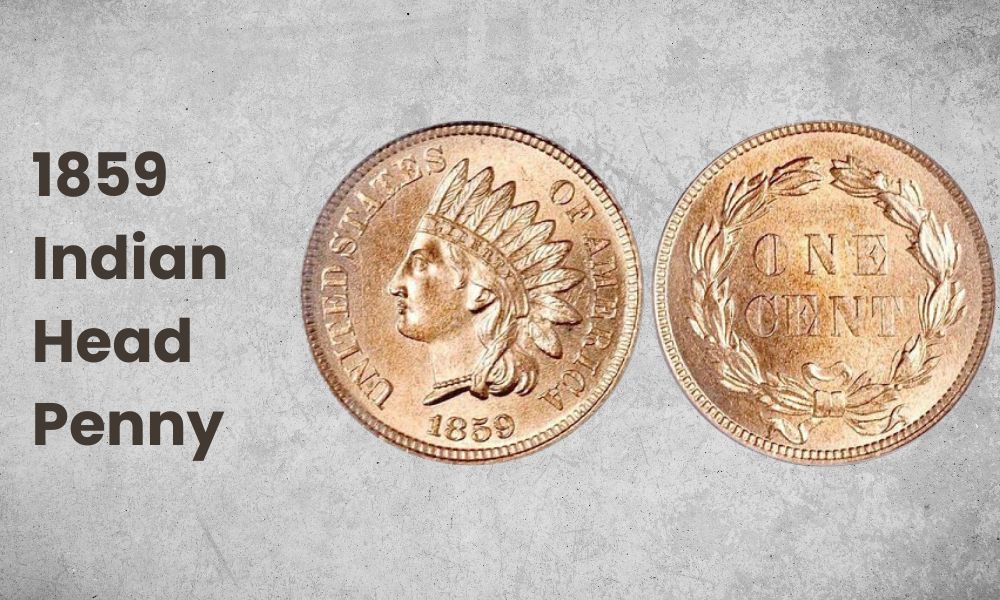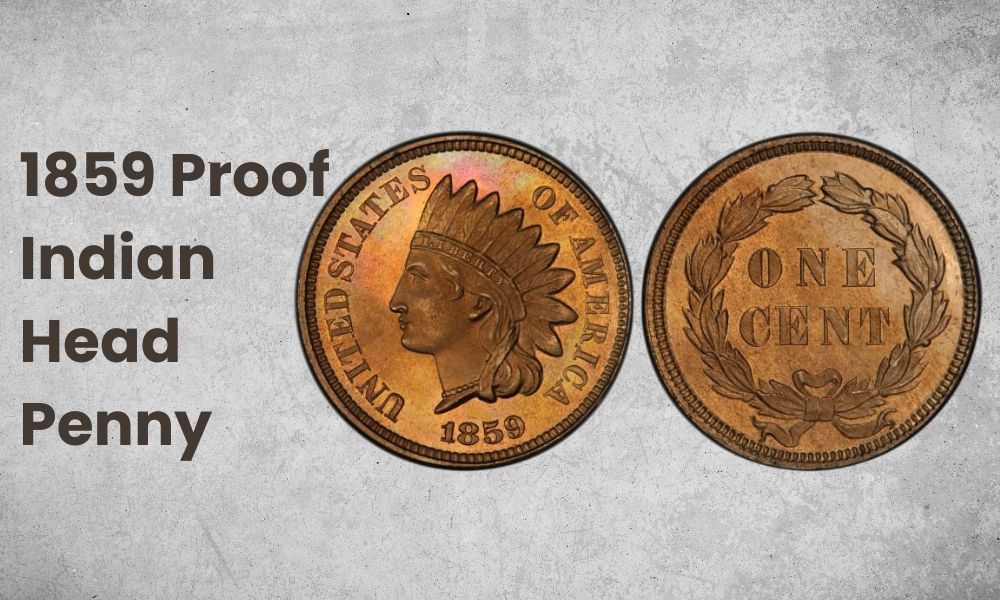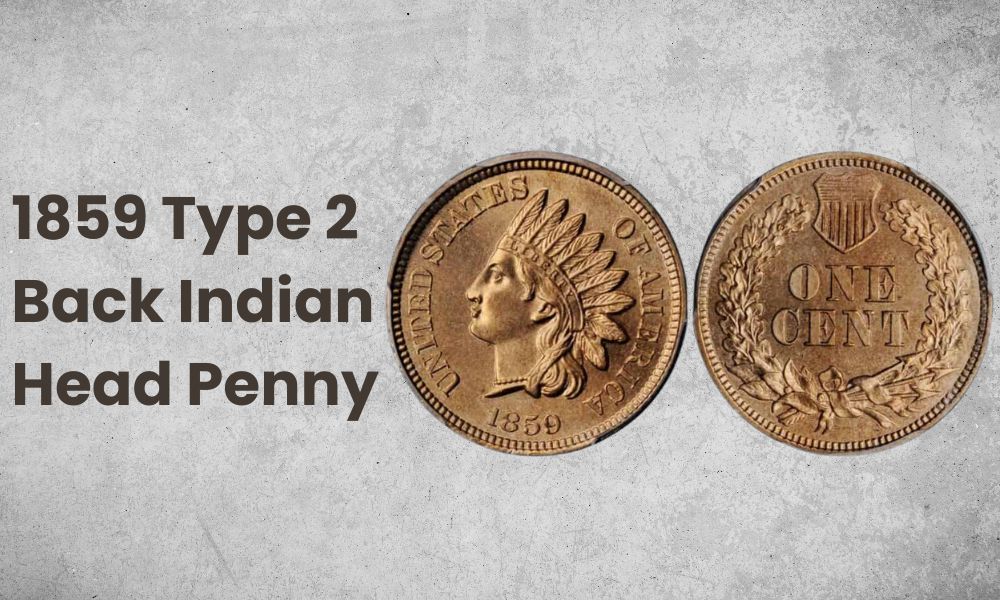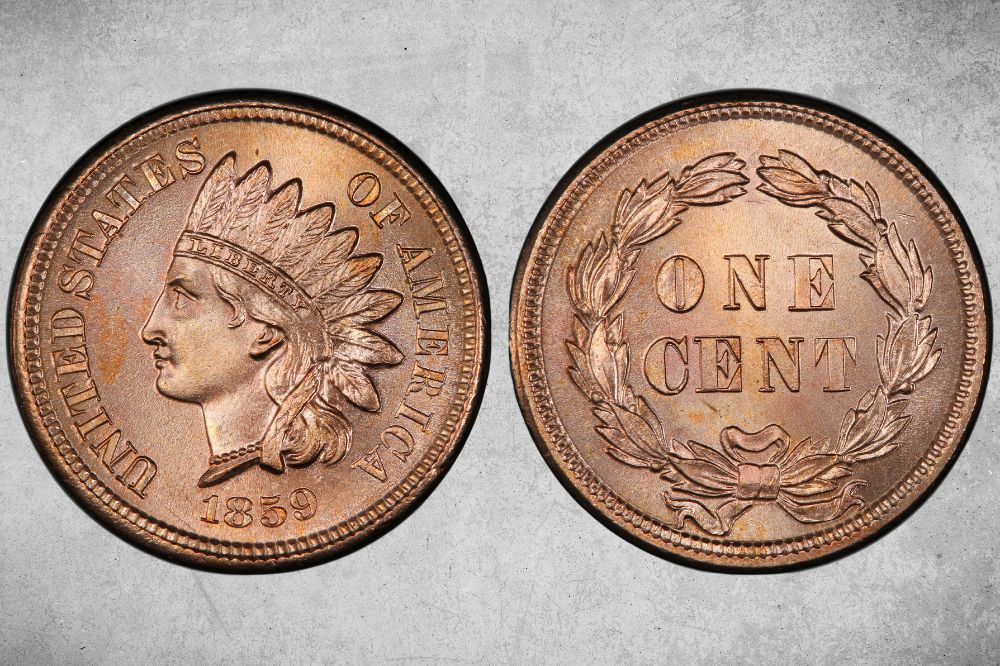The Indian Head penny is one of the most recognizable “old” coins for new collectors, and the 1859 Indian Head penny was the one to usher this design in. This year signified a major successful change for the U.S. Mint, and the cents have many desirable features to keep collectors entertained.
The value of the 1859 Indian Head penny depends mostly on the coin’s grade. Professional grading is essential for making a proper sale, but Mint State 1859 cents sell for tens of thousands at auctions.
In this guide, we explain the different types of 1859 Indian Head pennies and smaller details that may increase the value of your coin. Keep reading to learn more about their worth, history, grading, and well-known errors.
Let’s get started!
1859 Indian Head Penny Details
- Category: Indian Head Cent (1859 to 1909)
- Mint: Philadelphia
- Mintage: 36,400,800
- Obverse Designer: James Barton Longacre
- Reverse Designer: James Barton Longacre
- Composition: 88% copper, 12% nickel
- Weight: 4.67 grams
The 1859 Indian Head penny is considered a One Year Type. Not only was it the first year that the Indian Head design was minted and put into circulation, but the reverse design was changed the following year.
This coin’s obverse features a profile of a Native American woman wearing a headdress (commonly referred to as a feathered headband due to the historical inaccuracy of a woman wearing such a headdress).
The word LIBERTY is inscribed across the headband, and the coin reads UNITED STATES OF AMERICA along its edge. The year 1859 is stamped at the bottom of the coin.
The reverse features two laurel branches along the rim with a ribbon tying them together at the bottom. The denomination ONE CENT is printed in the center of the coin.
1859 Indian Head Penny Value Chart |
|||||
| Mint Mark | Good | Fine | Extremely Fine | Uncirculated | Proof |
| 1859 Indian Head Penny | $11 | $22 | $87 | $367 | / |
| 1859 Proof Indian Head Penny | / | / | / | / | $2,107+ |
| 1859 Type 2 Back Indian Head Penny | / | / | / | $1,200 | / |
1859 Indian Head Penny Value and Varieties Guide
There are two types of Indian Head pennies to look out for: the regular coin minted for circulation and the proof version. The regular coin is exactly as we describe at the beginning of the article, while proof versions feature different designs.
The value of these coins is very baseline, and it’s difficult to determine the actual market value for a coin this old. In reality, the high demand for the 1859 penny means you can sell a coin for thousands at auction with a proper high grade.
Even coins in poor condition may sell for well over their market value due to the scarcity of the coins. As long as you have a verifiably 1859 penny, you are holding onto a small treasure.
1859 Indian Head Penny Value

- Type: Indian Head Cent (1859 to 1909)
- Edge: Plain
- Mint Mark: N/A
- Place of Minting: Philadelphia
- Year of Minting: 1859
- Face Value: $0.01
- $ Price: $11 to $367+
- Quantity Produced: 36,400,000
- Designer: James Barton Longacre
- Mass: 4.67 grams
- Diameter: 19.00 mm
Philadelphia was the only mint to oversee the production of the 1859 Indian Head penny. While the San Francisco mint had opened five years prior, it was busy handling the load from the California gold mines in 1959.
The mint produced over 36 million one cent coins for circulation that year, although far less survive today. A regular 1859 Indian Head penny in rough condition regularly sells for $11, but uncirculated coins often go for $367 or more.
Many of these coins are no longer in circulation, but there’s a chance to happen across one at an expo or convention. If you’re looking for an 1859 penny to add to your collection, you can start with lower grade examples easily before pursuing mint state coins that sell for thousands of dollars.
The current 1859 Indian Head penny auction record belongs to a PCGS MS-66+ coin sold at Heritage Auction for $34,500 on February 2, 2012.
1859 Proof Indian Head Penny Value

- Type: Indian Head Cent (1859 to 1909)
- Edge: Plain
- Mint Mark: N/A
- Place of Minting: Philadelphia
- Year of Minting: 1859
- Face Value: $0.01
- $ Price: $2,107+
- Quantity Produced: 800
- Designer: James Barton Longacre
- Mass: 4.67 grams
- Diameter: 19.00 mm
The 1859 proof Indian Head penny is incredibly difficult to track down. Only a small amount were printed, and only about half of those survived the year. The other half were melted down when they were not sold.
An 1859 proof penny may have different patterns. The coins were not intended for circulation, and they were printed for collectors before the final design was confirmed.
The trial coins involve four different wreath reverse designs accompanied by either a Flying Eagle obverse (as seen in previous years), a scrawny eagle, or the Indian Head that was ultimately chosen.
The rarity of these coins is especially hard to put a price tag on, but we wouldn’t expect a proof coin to sell for any less than $2,107.
1859 Type 2 Back Indian Head Penny Value

- Type: Indian Head Cent (1859 to 1909)
- Edge: Plain
- Mint Mark: N/A
- Place of Minting: Philadelphia
- Year of Minting: 1859
- Face Value: $0.01
- $ Price: $1,200+
- Quantity Produced: 1,000
- Designer: James Barton Longacre
- Mass: 4.67 grams
- Diameter: 19.00 mm
The Type 2 Back Indian Head Penny sits somewhere between a proof and an error coin. While these coins were minted for circulation, they never made it into the hands of the public, and very few exist today.
These coins are dated 1859, but they feature the oak wreath and shield reverse that wasn’t released until the following year. Some may argue that they were only proof versions, but the luster of the coins and the lack of proof sale indicates otherwise.
The market value of these coins sits at $1,200, but expect one to sell for much more if it makes an appearance at auction.
1859 Indian Head Penny History
The origin of the 1859 Indian Head penny started at the beginning of the decade as copper prices began to spike. This led the U.S. Mint to create a smaller coin size to ensure economical production, but the Flying Eagle cent (1856 to 1858) had several production issues that led to an immediate need for a new design.
In 1858, the Mint created between 60 and 100 sets of 12 different combinations for the new cent (which are now highly desirable 1859 proof coins). Mint Director James Ross Snowden chose Indian Head obverse and Laurel Wreath reverse from these.
Designer James Barton Longacre created the Indian Head design because he saw it as a proper symbol of America and what it had inherited. The coin would later spark controversy due to the strong Caucasian features on the Indian Head, as well as a woman wearing a male Native American headdress.
While there are theories and tales about how the profile may resemble his own daughter, Longacre assured the public that the “Indian Head” was based on the Crouching Venus statue on loan from the Vatican at the time.
Despite these dramas, the production of the Indian Head cent began in 1859. In 1860, the reverse design was changed to an oak wreath with a shield at the top and arrows tied to the base. Some 1859 dated coins feature this reverse design.
During this time, the penny experienced some circulation issues. Many were exchanged for small Spanish silver, and the South and West rejected base metal money, causing an uneven distribution of the coins that promptly changed with the start of the American Civil War in 1861.
The Indian Head penny made it 50 years in production until it was replaced by the Lincoln Head penny in 1909. While the Indian Head penny is coveted by collectors, Theodore Roosevelt’s Renaissance of American Coinage sought a complete overhaul of the currency.
Also Read: Top 15 Most Valuable Indian Head Penny Worth Money
1859 Indian Head Penny Grading
While it’s best to use a professional grading service like Professional Coin Grading Service (PCGS) or the Numismatic Guarantee Company (NGC), you can do a preliminary assessment of your 1859 Indian Head penny.
Assigning a general grade such as “Good” or “Uncirculated” will not bear much weight in the appraisal of your coin, but it provides a greater understanding of the value and condition of the coin.
Good
Most 1859 Indian Head pennies are in “Good” condition or worse due to their age. As long as you can clearly identify the coin and the year, cents from this year are still desirable.
A “Good” coin has heavy wear, and many images are difficult to make out. All details on the coin have flattened out, leaving a flat silhouette on the front rather than a profile.
The headband, hair, and eye are no longer separated, and the curls of the hair have merged with the ribbon. Details on the reverse are equally worn.
Fine
An 1859 penny in “Fine” quality easily distinguishes all images, but there is significant wear to the coin. The hairline and headband are often merged together, and the loss of definition continues down the neck.
Images and words on the obverse and reverse of the Indian Head cent are worn down, but you should be able to make them out easily. These coins are also much more dull in appearance than higher grades, but they lack the beating of “Good” grades.
Extremely Fine
When an 1859 Indian Head penny is “Extremely Fine”, it has minor wear and tear to high points (such as the face) and details are only slightly worn. You often see flattening on the cheek, right below the eye, and the ribbon trailing off the headband.
Minor circulation has smoothed these coins, but this is more so due to gently changing hands that businesses use.
Uncirculated
Few “Uncirculated” 1859 Indian Head pennies remain today, but those that do are phenomenally preserved. All images are present, despite the trials of over 150 years of existence.
The age of the coin is reflected more in the color or tone of the coin. Focus your efforts on the cheekbones and feathers for anything that would drop the penny into the “Extremely Fine” category.
List of 1859 Indian Head Penny Errors
Many 1859 pennies have signs of damage that some may mistake for mint errors, but there are only a few acknowledged errors that increase the value of this coin. If you come across one with a rare error, make sure you have it verified by a professional.
Some pennies from this year have repunched dates, making them worth many times over their base value. This error is not obvious at first, but closer inspection reveals the ghost of the first impression and a slight shadowed appearance.
1859 Indian Head Penny FAQs
What Is the Value of an 1859 Indian Head Penny?
An 1859 Indian Head Penny is worth anywhere from $11 to $2,107 or often more, depending on the market. You’re most likely to find well-preserved 1859 pennies at auctions where they will sell for thousands of dollars.
Is an 1859 Penny Rare?
An 1859 penny is rare due to its age and conditions at the time. Proof pennies from this year are particularly rare, as only a few were made and many were melted down, but even circulated coins are difficult to track down or happen across without actively searching.
What Is an 1859 Indian Head Penny Made Of?
Pennies from 1859 are composed of 88 percent copper and 12 percent nickel.
How Many 1859 Indian Head Pennies Were Made?
About 36,400,800 Indian Head pennies were made in 1859, but few survive today. While some are in remarkable condition, over 150 years of circulation has worn through the majority of these coins.
Is the 1859 Cent Made of Brass?
The American 1859 cent is made of copper and nickel, while a rare Canadian coin error involved the Narrow 9 1859 large cent being made of brass rather than bronze.
